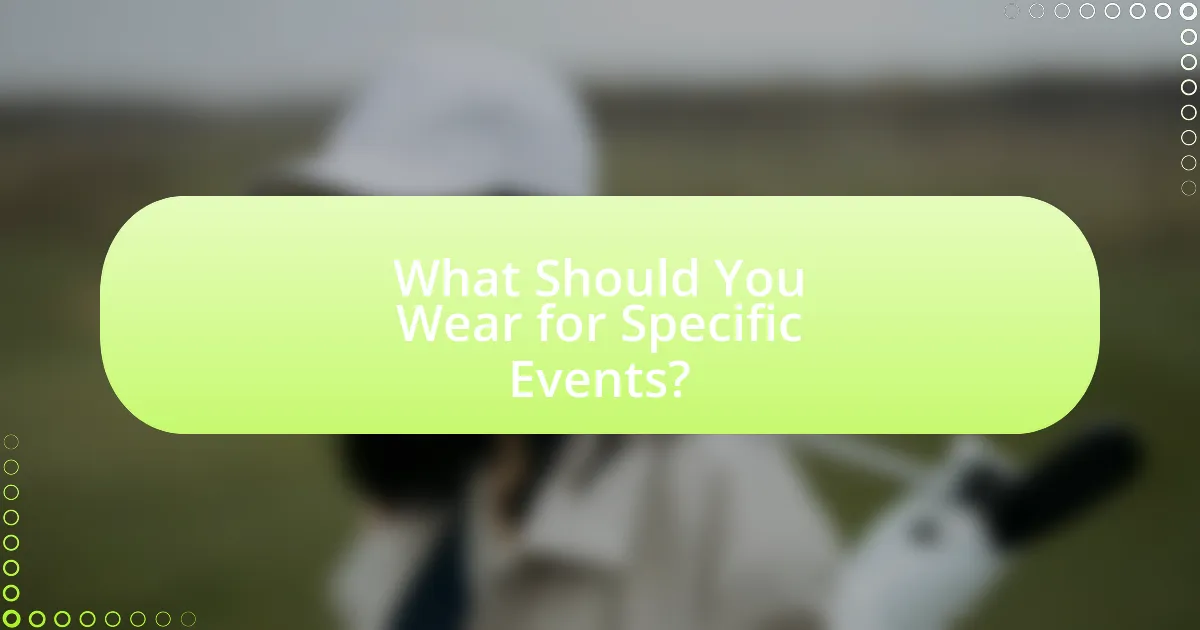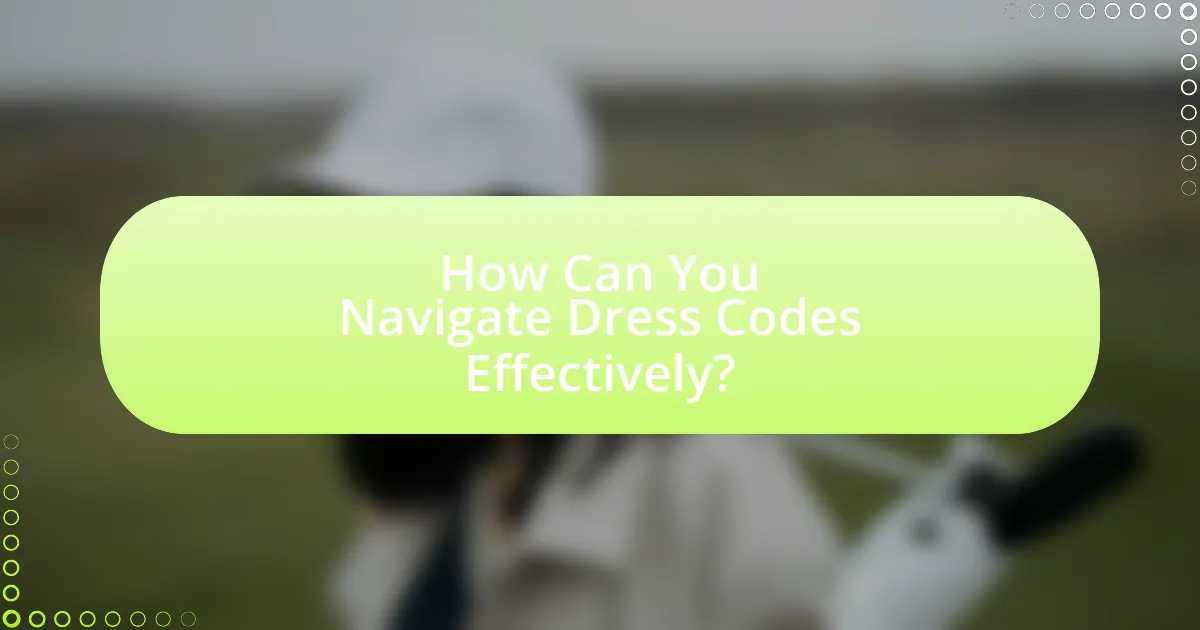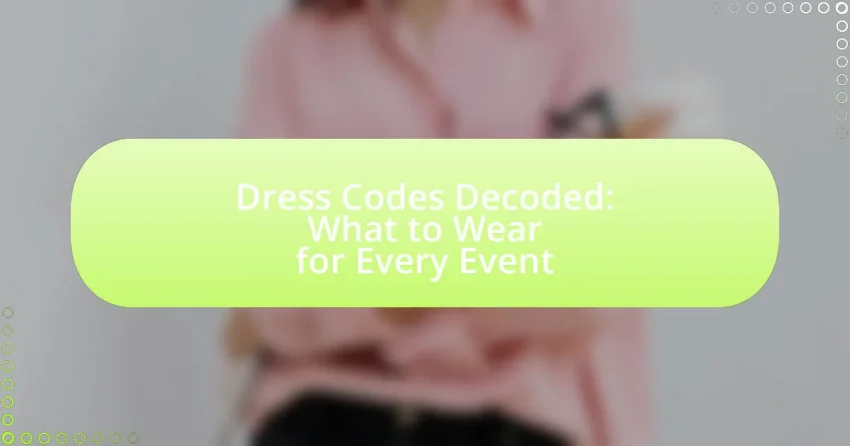Dress codes are essential guidelines that dictate appropriate attire for various occasions, influencing professionalism, social interactions, and cultural norms. This article explores the significance of dress codes, their historical origins, and how cultural differences shape expectations. It categorizes common types of dress codes, distinguishes between formal and casual attire, and provides specific recommendations for events such as weddings and corporate gatherings. Additionally, it offers practical tips for navigating dress codes effectively, interpreting terminology, and building a versatile wardrobe to ensure appropriate dressing for any occasion.

What are Dress Codes and Why Do They Matter?
Dress codes are a set of guidelines that dictate the appropriate attire for specific occasions or environments. They matter because they establish a standard of professionalism, promote a sense of belonging, and enhance the overall atmosphere of an event. For instance, formal dress codes in workplaces can improve employee morale and productivity, while casual dress codes at social gatherings can foster a relaxed environment. Research indicates that adherence to dress codes can positively influence perceptions of competence and authority, as seen in studies published in the Journal of Experimental Social Psychology, which highlight the impact of clothing on social interactions and judgments.
How do dress codes influence social interactions?
Dress codes significantly influence social interactions by establishing expectations for behavior and communication based on attire. When individuals adhere to specific dress codes, they signal their understanding of social norms, which can foster a sense of belonging and acceptance within a group. For instance, research indicates that formal attire can enhance perceptions of professionalism and authority, leading to more respectful interactions in workplace settings. Conversely, casual dress codes may promote a relaxed atmosphere, encouraging open dialogue and camaraderie among peers. These dynamics illustrate how clothing choices can shape social hierarchies and interpersonal relationships, ultimately affecting the quality and nature of interactions in various contexts.
What are the historical origins of dress codes?
The historical origins of dress codes can be traced back to ancient civilizations, where clothing was used to signify social status, occupation, and cultural identity. In ancient Egypt, for example, the pharaohs and nobility wore elaborate garments made from fine linen, while commoners wore simpler attire, establishing a clear social hierarchy. Similarly, in medieval Europe, sumptuary laws were enacted to regulate what individuals could wear based on their class, reinforcing societal structures and norms. These laws aimed to maintain distinctions between the wealthy and the poor, as well as to uphold moral standards. The evolution of dress codes continued through the Renaissance and into modern times, where formal attire became associated with specific events and social gatherings, further solidifying the role of clothing in societal expectations.
How do cultural differences affect dress codes?
Cultural differences significantly affect dress codes by dictating what is considered appropriate attire in various social contexts. For instance, in many Western cultures, business attire typically includes suits and ties for men and professional dresses for women, while in some Middle Eastern cultures, traditional garments like thobes for men and abayas for women are preferred in formal settings. These variations stem from historical, religious, and social norms that shape perceptions of modesty, professionalism, and identity. Research indicates that understanding these cultural nuances is crucial for effective communication and respect in diverse environments, as highlighted in studies on cross-cultural interactions.
What are the common types of dress codes?
The common types of dress codes include casual, business casual, business formal, cocktail, black tie, and white tie. Casual dress code allows for relaxed clothing, such as jeans and t-shirts, while business casual typically involves slacks and collared shirts. Business formal requires suits and ties for men and tailored dresses or suits for women. Cocktail attire is semi-formal, often featuring dresses or dressy separates. Black tie mandates tuxedos for men and elegant evening gowns for women, whereas white tie is the most formal, requiring tailcoats and full-length gowns. These classifications help individuals understand appropriate attire for various events.
What distinguishes formal from casual dress codes?
Formal dress codes require attire that is polished and sophisticated, typically including suits, ties, and formal dresses, while casual dress codes allow for more relaxed and comfortable clothing, such as jeans, t-shirts, and sneakers. The distinction lies in the level of formality and the setting; formal attire is often mandated for events like weddings or corporate functions, whereas casual attire is acceptable for informal gatherings or everyday wear. This differentiation is supported by societal norms and expectations surrounding various occasions, where adherence to formal dress codes reflects professionalism and respect for the event’s significance.
How do business casual and smart casual differ?
Business casual and smart casual differ primarily in their level of formality and specific clothing items. Business casual typically includes dress shirts, slacks, and closed-toe shoes, emphasizing a professional appearance suitable for workplace environments. In contrast, smart casual allows for more relaxed attire, such as polo shirts, blouses, and stylish sneakers, while still maintaining a polished look appropriate for social gatherings or less formal business settings. The distinction lies in the expectation of professionalism in business casual versus the flexibility and personal expression allowed in smart casual.

What Should You Wear for Specific Events?
For specific events, appropriate attire varies based on the occasion. For formal events, such as weddings or galas, men should wear a tuxedo or a dark suit, while women should opt for a formal gown or an elegant cocktail dress. Business events typically require business casual attire, where men can wear dress shirts with slacks and women can choose blouses with skirts or tailored pants. Casual events allow for more relaxed clothing, such as jeans and t-shirts for both genders. Understanding these dress codes is essential, as they reflect respect for the event and its hosts.
How do you choose an outfit for a wedding?
To choose an outfit for a wedding, first consider the wedding’s dress code, which can range from formal to casual. Understanding the specified dress code is crucial, as it dictates the level of formality required; for example, black-tie events typically require a tuxedo or formal gown, while casual weddings may allow for sundresses or smart-casual attire. Additionally, consider the venue and season, as outdoor weddings may necessitate lighter fabrics and comfortable footwear. Ultimately, selecting an outfit that aligns with the couple’s preferences and the overall theme of the wedding ensures appropriateness and respect for the occasion.
What are the typical dress codes for weddings?
Typical dress codes for weddings include formal, semi-formal, cocktail, and casual attire. Formal dress codes often require men to wear tuxedos and women to wear long evening gowns. Semi-formal attire allows for suits for men and cocktail dresses for women. Cocktail attire is less formal, typically involving dressy separates or shorter dresses. Casual dress codes permit more relaxed clothing, such as sundresses for women and slacks with a nice shirt for men. These classifications help guests understand the expected level of formality based on the couple’s preferences and the wedding’s setting.
How can you adapt your outfit for different wedding themes?
To adapt your outfit for different wedding themes, first identify the specific theme of the wedding, such as formal, semi-formal, beach, rustic, or cultural. For a formal wedding, choose a classic suit or elegant dress; for a semi-formal event, opt for a cocktail dress or dressy separates. Beach weddings call for lighter fabrics and casual attire, like sundresses or linen suits. Rustic themes often embrace earthy tones and textures, so consider wearing a flowy dress or tailored pants with a relaxed top. Cultural weddings may require traditional attire, so research the customs and dress codes associated with that culture. Adapting your outfit ensures you respect the couple’s vision while feeling comfortable and stylish.
What is appropriate attire for corporate events?
Appropriate attire for corporate events typically includes business formal or business casual clothing, depending on the event’s nature and company culture. Business formal attire often consists of tailored suits, dress shirts, ties for men, and professional dresses or suits for women. Business casual may allow for dress slacks, blouses, and smart shoes, providing a more relaxed yet polished appearance. The expectation for attire is supported by industry standards, where formal events necessitate a higher level of professionalism to reflect the company’s image and values.
What are the differences between business formal and business casual?
Business formal attire is characterized by tailored suits, dress shirts, ties, and polished shoes, while business casual attire allows for more relaxed clothing such as slacks, collared shirts, and closed-toe shoes without the need for a tie or jacket. The distinction lies in the level of professionalism and formality; business formal is typically required for high-stakes meetings, formal events, or corporate functions, whereas business casual is suitable for everyday office environments or less formal gatherings. This differentiation is supported by workplace dress code policies that outline expectations for employee attire based on the context of the event or work setting.
How can you dress appropriately for networking events?
To dress appropriately for networking events, choose attire that aligns with the event’s formality and industry standards. For example, business formal typically requires a tailored suit, dress shirt, and polished shoes, while business casual may allow for dress slacks and a collared shirt without a tie. Research indicates that 70% of professionals believe that dressing well positively impacts first impressions, highlighting the importance of appropriate attire in networking scenarios.

How Can You Navigate Dress Codes Effectively?
To navigate dress codes effectively, first understand the specific dress code requirements for the event, such as formal, semi-formal, business casual, or casual. Research indicates that clarity in dress code communication can reduce confusion; for instance, a survey by the Fashion Institute of Technology found that 70% of respondents felt more confident when they understood the expected attire. Next, consider the venue and the nature of the event, as these factors often influence appropriate attire. Finally, when in doubt, opt for slightly more formal attire than the stated dress code, as this demonstrates respect for the occasion and hosts.
What tips can help you interpret dress codes?
To interpret dress codes effectively, first, understand the terminology used in the dress code description. Common terms include “formal,” “business casual,” and “cocktail,” each indicating a specific level of dress. For example, “formal” typically requires a tuxedo or evening gown, while “business casual” allows for slacks and a collared shirt. Next, consider the context of the event, as the location and time can influence the appropriate attire; a daytime wedding may call for lighter fabrics compared to an evening gala. Additionally, researching the host or organization can provide insights into their expectations and style preferences. Finally, when in doubt, reaching out to the host for clarification can ensure you meet the dress code requirements accurately.
How can you ask for clarification on a dress code?
To ask for clarification on a dress code, directly contact the event organizer or host and inquire about specific guidelines. This approach ensures you receive accurate information tailored to the event’s expectations. For example, you might say, “Could you please clarify what is meant by ‘business casual’ for the upcoming event?” This method is effective because it demonstrates your willingness to adhere to the dress code while seeking the necessary details to comply correctly.
What resources can assist in understanding dress codes?
Resources that can assist in understanding dress codes include style guides, fashion websites, and etiquette books. Style guides, such as “The Little Black Book of Style” by Nina Garcia, provide detailed explanations of various dress codes and appropriate attire for different occasions. Fashion websites like Vogue and GQ offer articles and visual examples that clarify dress code expectations for events ranging from casual to formal. Additionally, etiquette books, such as “Emily Post’s Etiquette,” outline social norms and expectations regarding dress codes, helping individuals navigate what to wear in various settings.
What are common mistakes to avoid when dressing for events?
Common mistakes to avoid when dressing for events include failing to adhere to the specified dress code, which can lead to inappropriate attire for the occasion. For instance, wearing casual clothing to a formal event can create a negative impression. Additionally, neglecting to consider the venue’s environment, such as outdoor settings requiring different fabrics or styles, can result in discomfort. Overdressing or underdressing also poses a risk; for example, wearing a tuxedo to a casual gathering may draw unwanted attention. Lastly, ignoring personal comfort can detract from the overall experience, as uncomfortable clothing can hinder enjoyment and confidence.
How can you ensure your outfit aligns with the event’s tone?
To ensure your outfit aligns with the event’s tone, research the event’s dress code and theme beforehand. Understanding whether the event is formal, casual, or themed allows you to select appropriate attire that reflects the expected ambiance. For instance, a black-tie event necessitates formal wear such as tuxedos or evening gowns, while a casual gathering permits more relaxed clothing. Additionally, observing past events hosted by the same organization can provide insights into their style preferences, reinforcing your choice of outfit.
What should you consider when accessorizing for an event?
When accessorizing for an event, you should consider the event’s dress code, the overall outfit, and personal style. The dress code dictates the formality and appropriateness of accessories; for instance, a formal event may require elegant jewelry, while a casual gathering allows for more playful pieces. Additionally, the accessories should complement the outfit without overwhelming it, ensuring a cohesive look. Personal style plays a crucial role, as accessories should reflect individual taste while still adhering to the event’s expectations.
What are some best practices for dressing appropriately?
Dressing appropriately involves understanding the context of the event and adhering to its dress code. Best practices include researching the event type, such as formal, business casual, or casual, and selecting attire that aligns with those expectations. For instance, wearing a suit for a formal event or smart casual attire for a business meeting demonstrates respect for the occasion. Additionally, considering factors like weather, cultural norms, and personal comfort can enhance appropriateness. Studies show that appropriate dressing can positively influence perceptions and interactions, reinforcing the importance of aligning attire with situational expectations.
How can you build a versatile wardrobe for various dress codes?
To build a versatile wardrobe for various dress codes, focus on acquiring key staple pieces that can be mixed and matched. Essential items include a tailored blazer, a classic white shirt, versatile trousers, a little black dress, and quality footwear. These pieces can be dressed up or down depending on the occasion, allowing for adaptability across formal, business casual, and casual settings. For instance, a tailored blazer can elevate a simple outfit for a business meeting, while the little black dress can transition from a cocktail event to a dinner date with the right accessories. This approach is supported by fashion experts who emphasize the importance of foundational items in creating a flexible wardrobe that meets diverse dress code requirements.
What are the key elements of a well-coordinated outfit?
A well-coordinated outfit consists of color harmony, appropriate fit, and complementary styles. Color harmony ensures that the colors of the clothing items work well together, often following color theory principles such as complementary or analogous colors. Appropriate fit is crucial, as clothing should flatter the body shape and allow for comfortable movement. Complementary styles involve selecting pieces that align in terms of formality and aesthetic, such as pairing casual items with casual ones and formal items with formal ones. These elements collectively create a cohesive and visually appealing look, enhancing the overall impression of the outfit.
